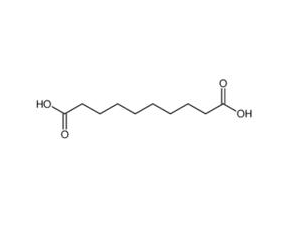
Sebacic acid
CAS No. 111-20-6
Sebacic acid ( 1,10-Decanedioic acid | Acide sebacique | Sebacinsaure )
产品货号. M17820 CAS No. 111-20-6
二恶嗪盐酸盐是异丙嗪的衍生物,对组胺有很强的H1受体阻断作用。
纯度: >98% (HPLC)
 COA
COA
 Datasheet
Datasheet
 HNMR
HNMR
 HPLC
HPLC
 MSDS
MSDS
 Handing Instructions
Handing Instructions
| 规格 | 价格/人民币 | 库存 | 数量 |
| 100MG | ¥340 | 有现货 |


|
| 200MG | 获取报价 | 有现货 |


|
| 500MG | 获取报价 | 有现货 |


|
| 1G | 获取报价 | 有现货 |


|
生物学信息
-
产品名称Sebacic acid
-
注意事项本公司产品仅用于科研实验,不得用于人体或动物的临床与诊断
-
产品简述二恶嗪盐酸盐是异丙嗪的衍生物,对组胺有很强的H1受体阻断作用。
-
产品描述Decanedioic acid aslo know as Sebacic acid. It is produced from castor oil by using sodium hydroxide, sulfuric acid with catalysts including zinc oxide and phenol.[citation needed] Byproducts include glycerol, octanol and polymer residue. Sebacic acid has been used in the synthesis of: biodegradable and elastomeric polyesters [poly(glycerol sebacate)], novel bio-nylon, PA5.10, novel temperature-response hydrogel based on poly(ether-ester anhydride) nanoparticle for drug-delivery applications.
-
体外实验——
-
体内实验——
-
同义词1,10-Decanedioic acid | Acide sebacique | Sebacinsaure
-
通路Others
-
靶点Other Targets
-
受体HIV
-
研究领域Others-Field
-
适应症——
化学信息
-
CAS Number111-20-6
-
分子量202.25
-
分子式C10H18O4
-
纯度>98% (HPLC)
-
溶解度In Vitro:?DMSO : ≥ 100 mg/mL (494.44 mM)
-
SMILESC(CCCCC(=O)O)CCCC(=O)O
-
化学全称decanedioic acid
运输与储存
-
储存条件(-20℃)
-
运输条件With Ice Pack
-
稳定性≥ 2 years
参考文献
1.Clemente Bretti, et al. Eng. Data. 51 (5): 1660–1667.
产品手册




关联产品
-
Cholestenone
4-Cholesten-3-one 是胆固醇的肠道代谢物。它对动物显示出抗肥胖作用。
-
gp120, HIV-1 MN
gp120, HIV-1 MN
-
(Arg)9 TFA
(Arg)9 TFA (Nona-L-arginine TFA) 是一种细胞穿透肽,在谷氨酸模型中表现出神经保护活性,IC50 为 0.78 μM。聚精氨酸(例如 (Arg)9)和富含精氨酸的肽(例如 TAT、penetratin)属于一类具有细胞穿透特性的肽,具有神经保护作用。



 021-51111890
021-51111890 购物车()
购物车()
 sales@molnova.cn
sales@molnova.cn







